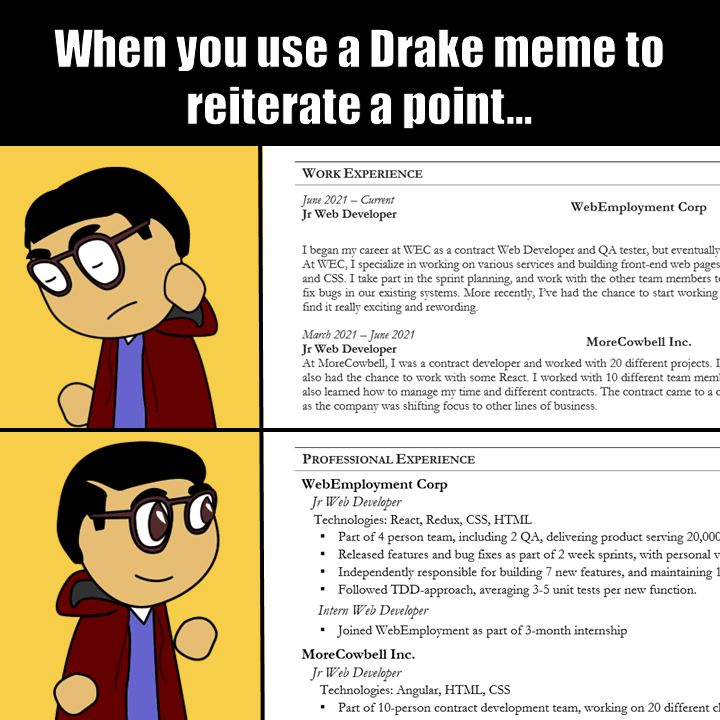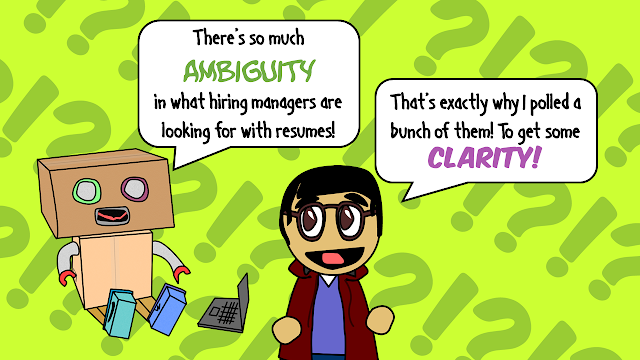Lumbot
There's a persona I've created for anything I do to advance my professional career.
If you're not familiar with the concept of personas, the idea is to not think of your users in generic ways. When you create real-life personalities, and define their goals and motivations, it helps ensure you're building the right thing. It's exactly what people mean when they say "know your audience" - but I'd go a little further to say: describe your audience.When it comes to your resume, portfolio, LinkedIn Profile, a key persona you want to consider is a Hiring Manager. It may not be your only persona -if you are putting out resources to help your peers, you may want to consider their personas as well. But, don't forget the Hiring Manager - the one who will one day hire you.
Lumbot is the hiring manager who has been following me since I was in college. I will neither confirm nor deny whether he's a pop-culture reference.Lumbot is always lurking around and watching my portfolio and experience grow. I build for him in mind - not just in terms of the projects I do, but how I present them, with the write-ups, and tone.
I like to imagine Lumbot as my biggest champion - waiting for the day I've gained enough experience for him to finally reveal himself and hire me. Now, to be clear, my life long dream isn't to work for Lumbot, it's just provides a useful context.
As my biggest fan, Lumbot is closely aware of my career progression - but it doesn't mean he remembers it all either. I give Lumbot the full picture each time - whether on my portfolio, resume or LinkedIn, but given that Lumbot is a busy executive - I also make sure I summarize down to the key take aways. I try to present Lumbot with the conclusions first, with evidence following after. Lumbot doesn't like long sentences. Lumbot wants bullets, and numbers. He wants the tl;dr (Lumbot would never read this article, so I'm safe telling you all this about him.)
Sometimes Lumbot works in a different industry, or he's looking to hire for the specific role I'm pursuing, but he's always the same same busy, impatient, and short-attention spanned hiring manager I've come to love.
As you build out your own footprint, think of your own Lumbot. Build with him or her in mind. It will help you focus your message, and focus your content.
Even if you're starting off early and don't have much to show, it's helpful to think about who is receiving your message.
At some point along the way, you'll start getting interviews and interviews will turn into offers. Keep thinking of your Lumbot. Keep refining your resume, and maintaining your portfolio as an online record of your career progression.
Overtime, you may update less frequently but your updates will be more impactful and your imaginary hiring manager will be excited to see how you've grown.
Eventually when you start looking for your next role, and you'll be embarrassed by your earlier self. The naïve resume, the basic things you showcased - and that's all ok. It's a sign of growth. Lumbot loves it. Instead of deleting it, revisit it. Lumbot will appreciate how you've matured.
Take the same approach with your GitHub too. Give it life and direct it at that same imaginary hiring manager.
It's easy to feel overwhelmed and sometimes like you're fighting a losing battle. Especially if you track your page views closely - you'll really feel like Lumbot's not really out there, not really watching you.
But Lumbot's there - because the truth is, Lumbot isn't really one person. Lumbot is made up of all the brief encounters you'll have with different hiring managers over your career. Lumbot is all of them, generalized and rolled into one.
Lumbot isn't as imaginary as you think - and when you build for Lumbot in mind, Lumbot cheers you on.
By the way, if you like the animation of Lumbot, here it is again... put to fine little ditty from 1902 by Scott Joplin, called Ragtime Dance...






